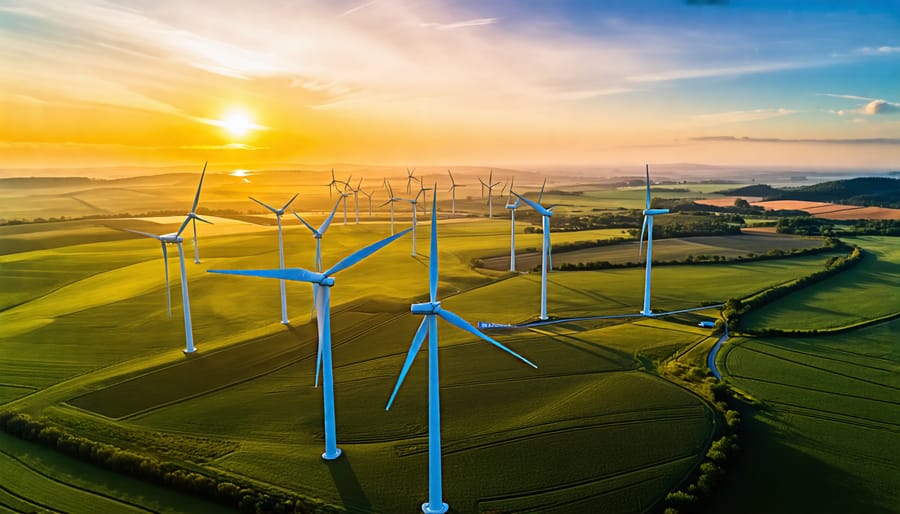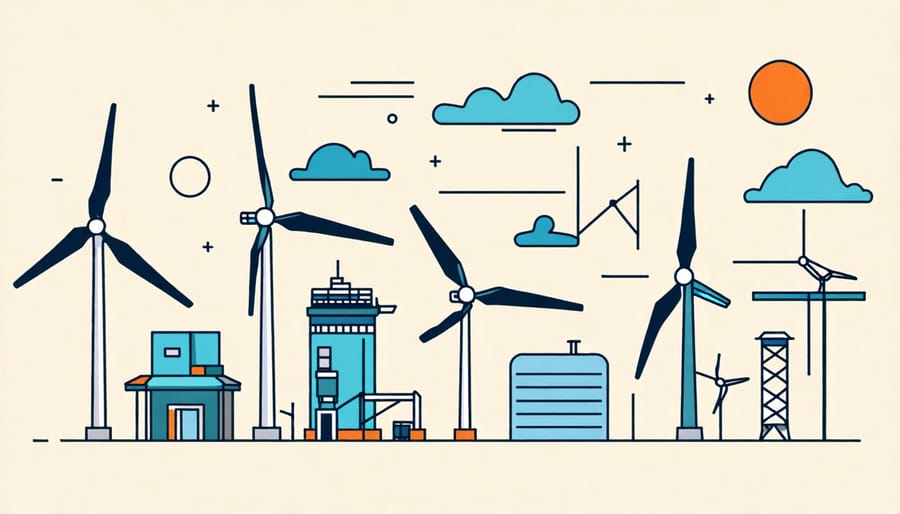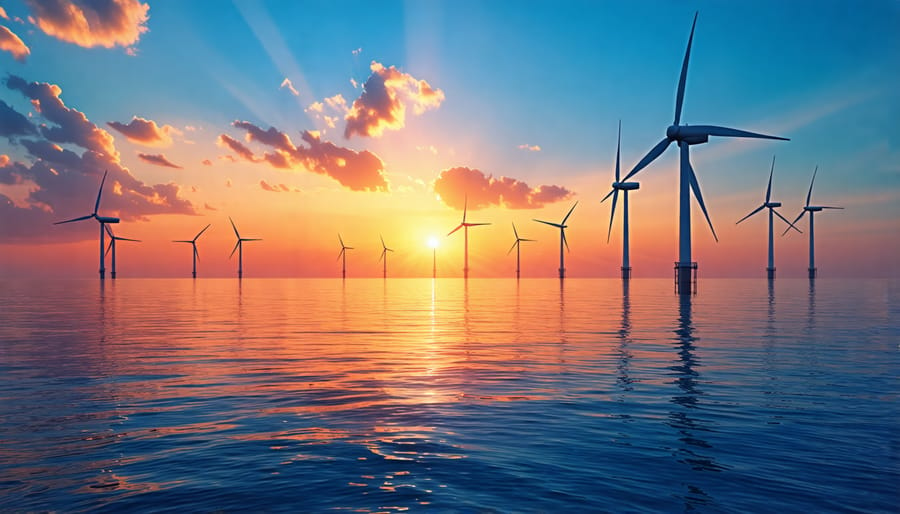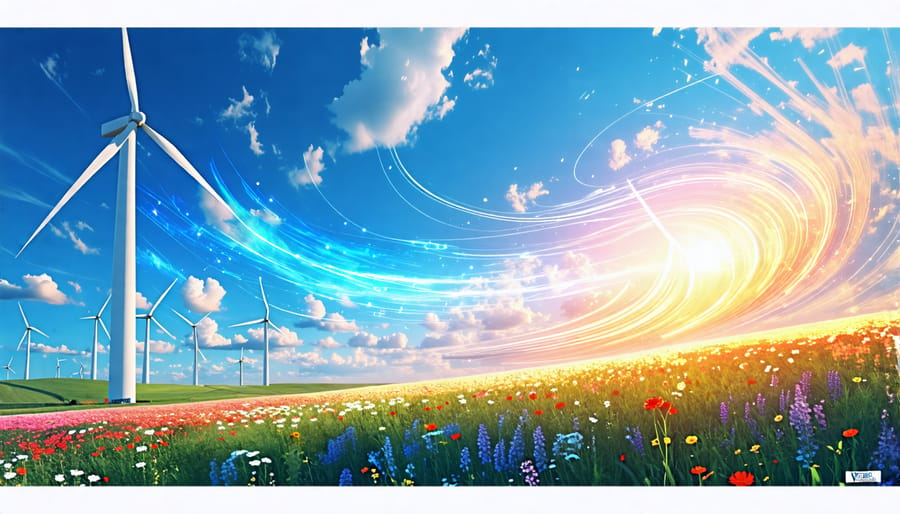Harness wind power by first understanding how wind turns into electricity through a wind turbine. This ingenious device captures kinetic energy from the wind using blades connected to a rotor. As the wind flows over the blades, it causes them to turn, rotating a connected generator. This generates electricity through electromagnetic induction, a process used in countless other energy-generating solutions.
Maximize efficiency by situating wind turbines in locations with consistent and robust wind patterns. Offshore sites often provide optimal conditions, taking advantage of stronger and more consistent oceanic winds. Placing turbines at higher altitudes can also harness more powerful wind currents, substantially boosting energy production capabilities.
Consider the scalability of wind farms to meet varying energy needs. Large-scale wind farms, often consisting of hundreds of turbines, can supply power to thousands of homes and businesses. Meanwhile, smaller installations can serve individual communities or even residential properties, demonstrating wind energy’s flexibility and adaptability.
Embrace the environmental benefits of wind energy, which significantly reduces reliance on fossil fuels and mitigates carbon emissions. By investing in this renewable energy source, communities worldwide can move toward a sustainable energy future that supports ecological balance and economic stability.
The Science Behind Wind Energy


Understanding Wind Turbines
Wind turbines are marvels of engineering that transform kinetic energy into electrical power, a crucial aspect of how wind turbines generate electricity. At the heart of their operation is the rotor, which comprises three large blades that catch the wind’s momentum. As the wind sweeps over the blades, they rotate around a central hub, similar to an airplane’s propeller slicing through the air.
This spinning action of the blades turns the rotor. The rotor is connected to the main shaft, which in turn, spins a generator situated in the nacelle—a sturdy, aerodynamic casing perched atop the tower. The generator is a key component, converting the rotational energy into electrical power. Inside, the rotational motion induces a magnetic field around copper coils, producing electricity through electromagnetic induction.
The efficiency and reliability of wind turbines are deeply influenced by their components. The blades, often made from lightweight composites, are designed with aerodynamic precision to maximize energy capture. Turbine towers, towering above landscapes at heights often exceeding 80 meters, ensure the blades reach higher altitudes where winds are more consistent.
In harnessing the wind’s power, wind turbines offer a clean and sustainable energy solution. Their presence in wind farms around the world not only generates impressive amounts of electricity but also stands as a testament to humanity’s shift towards green energy. Whether placed onshore, silently blending with the horizon, or offshore, where the ocean breeze is harnessed, wind turbines are pivotal in our journey towards a more sustainable future.
The Role of Airflow and Pressure
Wind energy is fundamentally driven by atmospheric phenomena, specifically the differences in air pressure. These variations occur because the Sun unevenly heats the Earth’s surface, causing warmer air to rise and cooler air to rush in to replace it. This movement generates wind. Imagine standing by the sea: during the day, land heats up faster than water, creating a difference in air pressure. The resulting breeze is a simple illustration of how wind patterns form.
Harnessing this natural force, wind turbines convert kinetic energy from wind into electrical power. As wind flows over turbine blades, it creates lift, much like an airplane wing, causing the blades to rotate. This rotation turns a generator, producing electricity. Reliable and efficient, wind power’s potential is immense, supported by continuous advancements in turbine technology. Innovators worldwide are optimizing airflow and pressure methods to maximize energy output, bolstering the role of wind as a cornerstone of sustainable energy solutions.
Technological Advancements in Wind Energy
Smart Turbines and IoT
Smart technology and the Internet of Things (IoT) are revolutionizing how wind turbines operate, significantly boosting their efficiency and reliability. By integrating sensors and IoT connectivity, these “smart turbines” can continuously monitor various parameters like wind speed, blade angle, and temperature, providing real-time data to operators. This constant stream of information allows for predictive maintenance, where potential issues can be addressed before they lead to costly breakdowns, thereby enhancing turbine uptime and reducing operational costs.
Furthermore, these technologies facilitate more precise adjustments to turbine settings, optimizing their performance based on current wind conditions. For instance, smart turbines can automatically adjust their blades to capture maximum energy, even in fluctuating wind conditions. In real-world applications, companies like Vestas and Siemens Gamesa are leveraging IoT to create turbine networks that communicate with each other, sharing data to predict weather changes, and optimize entire wind farms.
This innovation not only increases the efficiency of wind energy production but also supports the transition to a more sustainable energy future.
Offshore Wind Farms
Offshore wind farms represent a significant leap forward in harnessing wind energy, especially as the global focus shifts towards sustainable energy solutions. Situated in vast ocean expanses, these wind farms are strategically positioned to capture stronger and more consistent winds than their land-based counterparts, significantly boosting energy production. A compelling example can be seen in Denmark’s Horns Rev 3, a leading offshore wind farm contributing substantially to the nation’s green energy. Offshore turbines can produce up to twice the energy compared to onshore ones, making them vital in reducing our reliance on fossil fuels.
Moreover, these installations have a lesser environmental footprint on land, preserving natural habitats while still driving the transition to renewable energy. Community engagement and expert insights indicate a growing acceptance and enthusiasm for offshore wind projects, with policy-makers increasingly prioritizing investment. As technology advances, costs are expected to decline, making offshore wind a cornerstone of future green policies and a beacon of hope in the quest for a sustainable planet.

Environmental and Economic Benefits
Wind energy stands as a powerful testament to how innovative technology can harmonize with nature’s forces to deliver both environmental and economic benefits. By tapping into the kinetic power of wind, we significantly reduce our reliance on fossil fuels, which are responsible for a large portion of global greenhouse gas emissions. The shift towards wind energy is a crucial step in diminishing our collective carbon footprint, effectively mitigating climate change and its damaging environmental impacts.
The environmental benefits are but one aspect of the story; the economic implications are just as encouraging. The wind energy sector is a dynamic field with the potential for robust job creation. According to recent industry reports, thousands of jobs—from manufacturing and installation to maintenance—are supported by the growing need for wind turbines and related infrastructure. This burgeoning workforce not only amplifies local economic growth but also fosters a range of skill development opportunities, ensuring sustained employment in a rapidly evolving industry.
Moreover, wind power contributes to energy independence and security by diversifying energy sources and reducing the vulnerability associated with fuel supply disruptions. The cost of wind energy has plummeted in recent years, making it one of the most competitive sources of electricity. This downward trend in pricing helps stabilize energy costs for both consumers and businesses, providing long-term economic stability. Together, these environmental and economic advantages paint a hopeful picture of a sustainable energy future, where renewable solutions like wind play a critical role in preserving our planet for generations to come.
Real-Life Case Studies
One real-life example of wind energy’s success is the Horns Rev 2 wind farm in Denmark, a pioneering project that features 91 turbines generating enough electricity to power approximately 200,000 homes. Situated in the North Sea, it showcases the scalability of offshore wind energy, benefiting from strong, consistent winds. This project highlights the potential of offshore wind farms to significantly contribute to a nation’s renewable energy goals while minimizing land use.
In the United States, the expansive Alta Wind Energy Center in California is another remarkable case study. As one of the largest onshore wind farms in the world, it has a capacity of around 1,548 megawatts, powering over 450,000 homes annually. Its success underscores the potential for large-scale wind energy projects to bolster regional energy independence and reduce carbon emissions.
In Asia, the wind power initiatives on the Tamil Nadu coastline in India serve as an inspiring example of wind energy’s adaptability. By harnessing coastal winds, these projects have not only supported local communities with clean energy but also spurred economic development, creating jobs and fostering sustainable growth. These cases illustrate the diverse applications and immense benefits of wind energy across different geographical and socio-economic contexts, paving the way for a greener future.
Frequently Asked Questions About Wind Energy
Wind energy is an increasingly popular renewable resource, but it often comes with questions and misconceptions. Let’s address a few common ones. Many wonder, “How does wind energy actually work?” Essentially, wind turbines convert kinetic energy from the wind into mechanical power, which a generator then transforms into electricity. Concerns about noise and wildlife impact are prevalent; however, technological advances have significantly reduced turbine noise, and careful placement of farms helps minimize effects on bird populations. Another question is “Is wind energy cost-effective?” As the technology improves and becomes more widespread, the costs continue to decrease, making wind energy one of the most economical renewable options available.
Conclusion: The Future of Wind Energy
As we look toward the future of wind energy, its role as a cornerstone of sustainable energy solutions becomes increasingly clear. With advancements in turbine technology and more efficient energy storage systems, wind power is poised to meet a substantial portion of global energy needs. Wind energy not only provides a clean, renewable resource, but it also stimulates economic growth by creating jobs in manufacturing, installation, and maintenance. Moreover, regions investing in wind energy experience greater energy independence and resilience against fluctuating fossil fuel prices. Cutting-edge developments include offshore wind farms, which harness stronger and more consistent winds to generate even more power. In places like Europe and the United States, these initiatives have significantly boosted energy outputs. As more nations commit to reducing carbon emissions, wind energy will be vital in achieving these ambitious goals. The wind energy sector continues to inspire confidence and engagement, representing a hopeful trajectory for a sustainable future.





